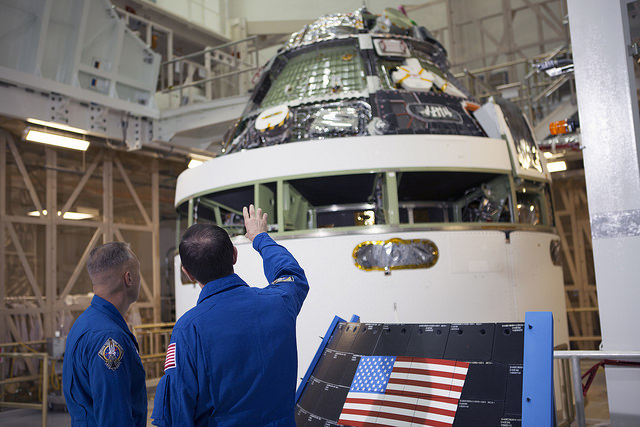
Late last night, NASA rolled out to the launch pad the Orion crew module, the first spacecraft designed to carry human explorers on deep space missions beyond the moon, to asteroids, and eventually Mars. The rollout was one of the final steps in preparing the spacecraft for its first test flight aboard a United Launch Alliance (ULA) Delta IV Heavy launch vehicle from Cape Canaveral on Dec. 4.
While the first test flight signifies a huge step for the nation in our return to human spaceflight, Colorado leaders have launched an aggressive campaign that is designed to showcase how the state’s aerospace industry has played a key role in Orion’s development and is leading the innovation that is powering the nation’s return to human space flight.
Colorado-based Lockheed Martin Space Systems leads the Orion industry team as the prime contractor building the Orion spacecraft, after winning the contract from NASA in 2006. Another Colorado company, ULA, will launch the Orion spacecraft on a Delta IV Heavy rocket, the world’s largest and most powerful launch vehicle flying today.
The uncrewed flight will take Orion to an altitude of approximately 3,600 miles above the Earth’s surface, more than 15 times farther than the International Space Station’s orbital position, before reentering the atmosphere and landing in the Pacific Ocean four and a half hours later.
With a focus on how “The Next Giant Leap into Space begins in Colorado,” the campaign is taking to the airwaves and social media in an effort to shine a national spotlight on Colorado’s impressive aerospace economy.
“Colorado aerospace companies are at the forefront of space travel, exploration, and research,” said Gov. John Hickenlooper. “By celebrating the leading role that our companies have played in the nation’s return to human spaceflight with Orion, we also spread awareness of how this extremely high-tech, high-value sector benefits Colorado businesses and our economy.”
Major space projects such as the Orion spacecraft have contributed close to 170,000 space-related jobs in the state, which is also home to more than 400 space-related companies. Aerospace is one of Colorado’s highest paying industry sectors, with aerospace workers making an average annual salary of $127,000. Colorado also ranks first in the nation for the number of private aerospace workers per capita.
The “The Next Giant Leap into Space begins in Colorado” campaign will not only celebrate the Orion spacecraft launch, but will also highlight these key industry facts.
Key elements of the campaign include features on Colorado-based aerospace engineers and scientists who helped develop Orion, support of Lockheed Martin’s #MarsWalk social media campaign, and the gubernatorial proclamation of Dec. 4 as Orion Space Exploration Day in Colorado. The campaign will also focus heavily on social media, enlisting Colorado space companies to spread awareness of Colorado’s “#MileCloser” role with the upcoming Orion launch through their digital networks.
“Colorado has been a world-class leader in space exploration and innovation since the founding of our industry, and it continues to be a place where space businesses thrive,” said Jim Crocker, Vice President and General Manager of Civil Space at Lockheed Martin. “This campaign not only showcases the important steps NASA is taking to push the boundaries of exploration, it also sends a message to the nation that our state continues to be at the cutting edge of aerospace technology.”
“This is a tremendous milestone for the nation’s next steps into deep space and for Colorado aerospace,” said Tory Bruno, president and CEO of ULA. “The Orion project is yet another example of the team effort and innovative relationships demonstrated between Colorado companies.”
To learn more about Colorado’s space economy, visit the Colorado Space Coalition’s website at www.spacecolorado.org.
Janet Fritz is the senior director of marketing and technology for the Metro Denver Economic Development Corporation. This post originally appeared here.
[Photo by: NASA Kennedy]
